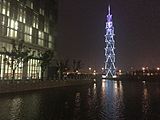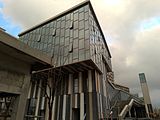ShanghaiTech University
| ShanghaiTech University | |
|---|---|
| founding | September 30th, 2013 |
| Sponsorship | state |
| place | Shanghai , People's Republic of China |
| president | Jiang Mianheng |
| Students | 2155 (2016) |
| Professors | 100 |
| Website | www.shanghaitech.edu.cn |
Coordinates: 31 ° 10 ′ 46 ″ N , 121 ° 35 ′ 26 ″ E ShanghaiTech University ( abbreviation : 上海 科技 大学; traditional character : 上海 科技 大學; pinyin : Shànghǎi Kējì Dàxué ) is a new research university in Shanghai , People's Republic of China with the campus in Zhangjiang Hi-Tech Park and a temporary building in downtown Shanghai.
The university was founded jointly by the City of Shanghai and the Chinese Academy of Sciences in 2013 .
ShanghaiTech has cooperation agreements with several foreign universities, e.g. E.g .: University of California, Berkeley , University of Chicago , Massachusetts Institute of Technology , Drexel University , University of Padua and USC School of Cinematic Arts .
Timeline
- December 2016: ShanghaiTech has moved to the new campus in Zhangjiang.
- Spring 2016: The first master’s students graduated from ShanghaiTech University.
- September 30, 2014: Start of studies for the first 207 Bachelor students.
- February 2014: Founding President Jiang Mianheng and University Council Chairman Zhu Zhiyuan are appointed.
- January 24, 2014: The Chinese Ministry of Education approves ShanghaiTechs 2014 undergraduate study program.
- September 30, 2013: The Chinese Ministry of Education approves the establishment of ShanghaiTech University.
- September 3, 2013: The first 296 postgraduate students begin their studies.
- December 28, 2012: Laying of the foundation stone for the new campus in the Pudong Science and Technology Park.
- April 28, 2012: The Chinese Ministry of Education approves plans for ShanghaiTech University.
- May 23, 2011: The Shanghai City Council and the Chinese Academy of Sciences (CAS) jointly decide to establish the "ShanghaiTech Development Steering Group" and the "ShanghaiTech Development Working Group".
- September 26, 2008: The Chinese Academy of Sciences (CAS) and the Shanghai City Council sign a cooperation agreement for the joint establishment of the Shanghai Pudong Science and Technology Park of CAS, the Shanghai Advanced Research Institute (SARI) of the CAS, and a research university.
- June 23, 2004: The Shanghai City Council and the Chinese Academy of Sciences (CAS) initiate planning for a research university in Pudong .
Departments and institutes
The university has four faculties (as of 2015) and one more is planned:
- Physics: School of Physical Science And Technology; Dean: Peidong Yang
- Computer Science, Mathematics, and Electrical Engineering: School of Information Science And Technology; Dean: Cher Wang
- Biology: School of Life Science And Technology; Dean: Haifan Lin
- Economics: School of Entrepreneurship And Management; Dean: Rosaline May Lee
- (Planned) Art: School of Art And Creativity
There are two research institutes:
- Shanghai Institute For Advanced Immunochemical Studies; Director: Richard A. Lerner
- iHuman Institute; Director: Raymond C. Stevens
campus
The campus is located in Zhangjiang Township, Pudong District . Due to its location in the Zhangjiang Hi-Tech Park, many national and international research and development companies are located near the university. The Shanghai Synchrotron Radiation Facility, the Shanghai Advanced Research Institute and the National Center for Protein Science Shanghai can be found in the immediate vicinity. The campus was designed by Moore Ruble Yudell Architects and won the "Merit Award for Urban Design Award 2012 from the American Institute of Architects, California Council".
The campus has an area of 0.6 square kilometers and a usable area of more than 700,000 square meters. The construction costs were estimated at 4.169 billion CNY . The campus was completed in 2016.
Bachelor students have been taught there since autumn 2014 and all lectures have been taking place on the new campus since autumn 2015.
Second campus in the city center
On the premises of the Chinese Academy of Sciences in the Xuhui district of Shanghai, ShanghaiTech University has some facilities for administration and research collaboration.
Research and Teaching
In 2017, the university had 100 tenure-track professors of its own and 287 affiliated professors, mainly from the Chinese Academy of Sciences. In the future, 1,000 professors are to teach there - 500 in-house and 500 affiliated. The number of students is expected to grow from 853 bachelors and 1,302 postgraduates (as of March 2017) to 2,000 undergraduate and 4,000 graduate students (including 3,000 doctoral students). The low student-to-professor ratio of at most 12: 1 is intended to ensure first-class teaching quality.
There are three Nobel Prize winners at ShanghaiTech University. Dr. Roger D. Kornberg , 2006 Nobel Prize in Chemistry , and James E. Rothman , 2013 Nobel Prize in Physiology or Medicine , are Distinguished Professors-in-Residence at the Shanghai Institute for Advanced Immunochemical Studies (SIAIS). Kurt Wüthrich , 2002 Nobel Prize in Chemistry, is a Distinguished Professor-in-Residence at the iHuman Institute.
Bachelor program
The bachelor's degree at ShanghaiTech University lasts four years and is divided into three semesters in each school year, with the one-month summer semester being reserved mainly for project courses and other art and further education classes.
The university places great value on liberal education and the teaching of creative skills. Some original courses have been developed such as "Introduction to Information Science and Technology", Introduction to Chinese Civilization, and Introduction to Global Civilization.
The "School of Entrepreneurship And Management" offers courses for students from all disciplines, for example Design Thinking .
Graduate program
Currently (as of November 2015) the university awards degrees from the Chinese Academy of Sciences. As soon as the newly developed courses are accredited by the Chinese Ministry of Education, ShanghaiTech University will offer its own degrees.
gallery

See also
Individual evidence
- ↑ https://www.crunchbase.com/person/jiang-mianheng#section-overview
- ↑ a b c ShanghaiTech at a glance. Retrieved March 2, 2017.
-
↑
- ShanghaiTech Signs Memorandum of Understanding with UC Berkeley.Retrieved November 19, 2015
- Global partnerships Berkeley Engineering. Retrieved November 19, 2015
-
↑
- ShanghaiTech Leadership Visits University of Chicago and University of California Berkeley. Retrieved November 19, 2015
- School of Physical Science and Technology Signs Agreement with the Institute of Molecular Engineering, University of Chicago.Retrieved November 19, 2015
-
↑
- President Jiang Signs Student Program Agreement with MIT.Retrieved November 19, 2015
- MIT-China Educational Technology Initiative Map. Retrieved November 19, 2015
- ^ Drexel University Partnership with Shanghai Tech.Retrieved November 19, 2015
- ^ University of Padova Rector Visits ShanghaiTech.Retrieved November 19, 2015
- ↑ It's really all in the wording.Retrieved November 19, 2015
- ^ Research, Technology and Profound Harmony Come Together.Retrieved November 19, 2015.
- ↑ Planning & Urban Design ShanghaiTech University.Retrieved November 19, 2015
- ↑ ShanghaiTech Campus Plan.Retrieved November 19, 2015
- ↑ ShanghaiTech Aims To Raise The Bar For Higher Education In China.Retrieved November 19, 2015







